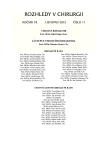Minimally invasive video-assisted operations for heart disease
Authors:
M. Pojar 1; J. Vojáček 1; J. Harrer 1; Z. Turek 2; J. Samek 2; N. Omran 1; M. Volt 1
Authors‘ workplace:
Kardiochirurgická klinika LF UK a FN v Hradci Králové, přednosta: Prof. MUDr. J. Harrer, CSc.
1; Klinika anesteziologie, resuscitace a intenzivní medicíny LF UK a FN v Hradci Králové
přednosta: Prof. MUDr. V. Černý, Ph. D., FCCM
2
Published in:
Rozhl. Chir., 2013, roč. 92, č. 11, s. 644-649.
Category:
Original articles
Overview
Introduction:
Minimally invasive surgical access for the treatment of mitral and tricuspid valves has become an alternative method to the conventional approach via median sternotomy. The aim of this paper is to evaluate our experience and results with minimally invasive approach in cardiac surgery at our institution.
Material and methods:
A total of 52 patients underwent minimally invasive cardiac surgery between November 2011 and March 2013. Right lateral minithoracotomy and femoral vessels cannulation for cardiopulmonary bypass was used. Follow-up data was collected in a prospective database and analysed retrospectively.
Results:
The mean age of patients was 60.9 ± 11.6 years (female patients accounted for 63.5%). The procedures performed included mitral valve repair in 44 (85%) patients and tricuspid valve repair in 25 (48%). Atrial septal defect closure was performed in 8 (15%) patients and cryoablation of atrial fibrillation in 26 (50%) patients. There were 75% combined procedures. The median duration of the operation was 235 (155–315) minutes. The median length of cardiopulmonary bypass and crossclamp time was 139 (89–225) and 92 (51–168) minutes, respectively. The median duration of postoperative hospital stay was 12.5 (6–34) days. Hospital and 30-day mortality was 0%. At follow-up (121.3 ± 32.72 days), two patients (3.8%) required reoperation (1 for right haemothorax, 1 for aortic valve insufficiency).
Conclusion:
Minimally invasive access has been adopted as a routine method for the therapy of valve disease. The minithoracotomy approach is a safe and feasible technique with comparable mortality and in-hospital morbidity.
Key words:
minimally invasive cardiac surgery – video-assisted approach – minithoracotomy
Sources
1. Modi P, Rodriguez E, Hargrove 3rd WC, et al. Minimally invasive video-assisted mitral valve surgery: a 12-year, 2-center experience in 1178 patients. J Thorac Cardiovasc Surg 2009;137 : 1481–1487.
2. Cuadrado DG, Leacche M, Byrne JG. Minimally invasive surgery for valvular heart disease. Curr Treat Options Cardiovasc Med 2012;14 : 584–593.
3. Iribarne A, Easterwood R, Chan EY, et al. The golden age of minimally invasive cardiothoracic surgery: current and future perspectives. Future Cardiol 2011;7 : 333–346.
4. Carpentier A, Loulmet D, Carpentier A, et al. Open heart operation under videosurgery and minithoracotomy. First case (mitral valvuloplasty) operated with success. C R Acad Sci III 1996;319 : 219–223.
5. Honěk T, Spatenka J, Hájek T, et al. Minithoracotomy in cardiac surgery. Initial experience with closure of an atrial septal defect with a minithoracotomy. Rozhl Chir 1996;75 : 286–289.
6. Branny P, Janík M, Holek B, et al. Videoasistované výkony na otevřeném srdci – naše zkušenosti. CorVasa 2010;52 : 597–599.
7. Casselman FP, Van Slycke S, Wellens F, et al. Mitral valve surgery can now routinely be performed endoscopically. Circulation 2003;108 (Suppl 1):48–54.
8. Cheng DC, Martin J, Lal A, et al. Minimally invasive versus conventional open mitral valve surgery: a meta-analysis and systematic review. Innovations 2011;6 : 84–103.
9. Falk V, Cheng DC, Martin J, et al. Minimally invasive versus open mitral valve surgery: a consensus statement of the international society of minimally invasive coronary surgery (ISMICS) 2010. Innovations 2011;6 : 66–76.
10. Lapenna E, Torracca L, De Bonis M, et al. Minimally invasive mitral valve repair in the context of Barlow‘s disease. Ann Thorac Surg 2005;79 : 1496–1499.
11. Seeburger J, Borger MA, Doll N, et al. Comparison of outcomes of minimally invasive mitral valve surgery for posterior, anterior and bileaflet prolapse. Eur J Cardiothorac Surg 2009;36 : 532–538.
12. Santana O, Reyna J, Benjo AM, et al. Outcomes of minimally invasive valve surgery in patients with chronic obstructive pulmonary disease. Eur J Cardiothorac Surg 2012;42 : 648–652.
13. Santana O, Reyna J, Grana R, et al. Outcomes of minimally invasive valve surgery versus standard sternotomy in obese patients undergoing isolated valve surgery. Ann Thorac Surg 2011;91 : 406–410.
14. Casselman FP, La Meir M, Jeanmart H, et al. Endoscopic mitral and tricuspid valve surgery after previous cardiac surgery. Circulation 2007;116(Suppl):1270–1275.
15. Chan EY, Lumbao DM, Iribarne A, et al. Evolution of cannulation techniques for minimally invasive cardiac surgery: a 10-year journey. Innovations 2012;7 : 9–14.
16. Mohr FW, Falk V, Diegeler A, et al. Minimally invasive port-access mitral valve surgery. J Thorac Cardiovasc Surg 1998;115 : 567–574.
17. Vanermen H, Farhat F, Wellens F, et al. Minimally invasive video-assisted mitral valve surgery: from Port-Access towards a totally endoscopic procedure. J Card Surg 2000;15 : 51–60.
18. Nifong LW, Rodriguez E, Chitwood Jr.WR. 540 consecutive robotic mitral valve repairs including concomitant atrial fibrillation cryoablation. Ann Thorac Surg 2012;94 : 38–42.
Labels
Surgery Orthopaedics Trauma surgeryArticle was published in
Perspectives in Surgery

2013 Issue 11
Most read in this issue
- Chest drainage systems and the complications associated with drainage.
- Chest drainage methods
- Chest drainage – physiological and pathophysiological aspects and indications
- Reconstruction of complex abdominal wall defects using the component separation technique
